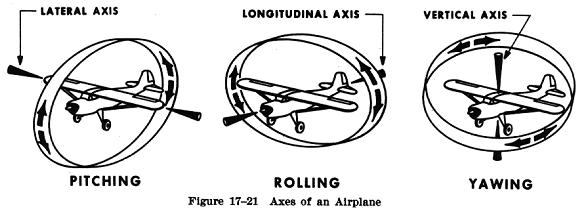
Whenever an airplane changes its flight attitude or position in flight, it rotates about one or more of three axes, which are imaginary lines that pass through the airplane's center of gravity. The axes of an airplane can be considered as imaginary axles around which the airplane turns, much like the axle around which a wheel rotates. At the point where all three axes intersect, each is at a 90 degree angle to the other two. The axis which extends lengthwise through the fuselage from the nose to the tail is called the longitudinal axis. The axis which extends crosswise, from wingtip to wingtip, is the lateral axis. The axis which passes vertically through the center of gravity, is called the vertical axis (Fig. 17-21).

The airplane's motion about its longitudinal axis resembles the roll of a ship from side to side. In fact, the names used in describing the motion about an airplane's three axes were originally nautical terms. They have been adapted to aeronautical terminology because of the similarity of motion between an airplane and the seagoing ship.
In light of the adoption of nautical terms, the motion about the airplane's longitudinal axis is called "roll;" motion about its lateral axis is referred to as "pitch." Finally an airplane moves about its vertical axis in a motion which is termed "yaw" - that is, a horizontal (left and right) movement of the airplane's nose.
The three motions of the airplane - roll, pitch, and yaw
- are controlled by three control surfaces. Roll is controlled by the ailerons;
pitch is controlled by the elevators; yaw is controlled by the rudder.
The use of these controls was explained in the chapter on Use and Effect
of Controls.